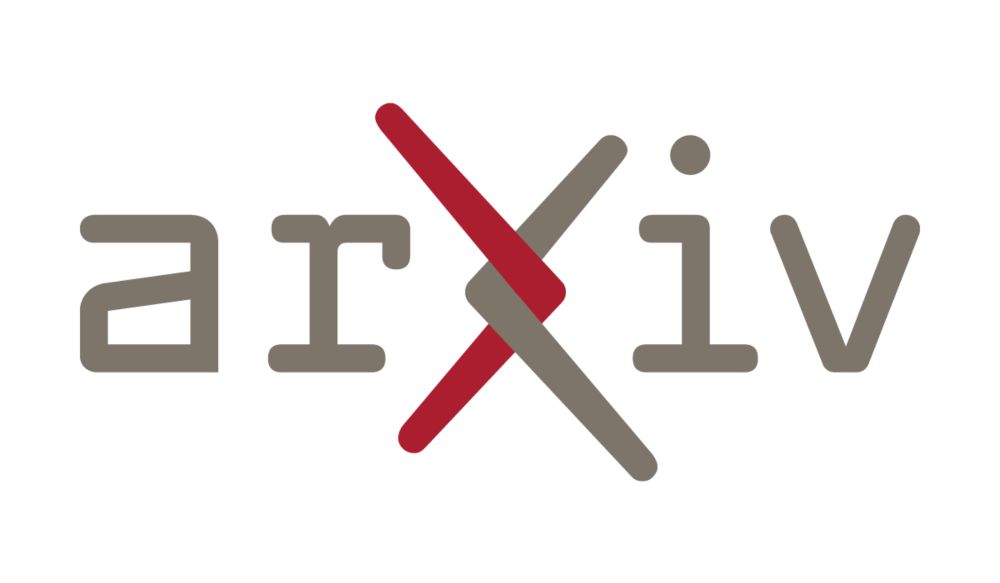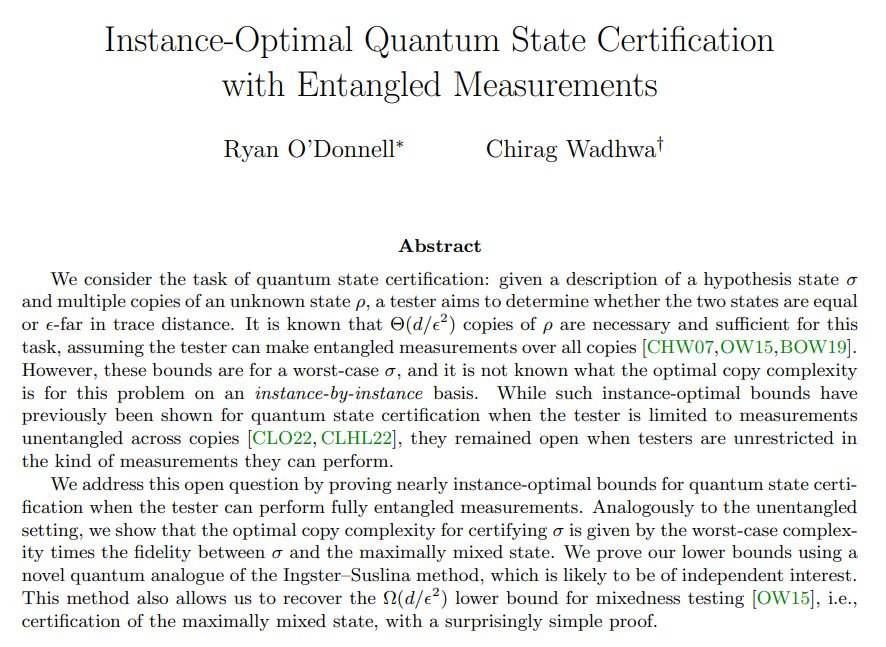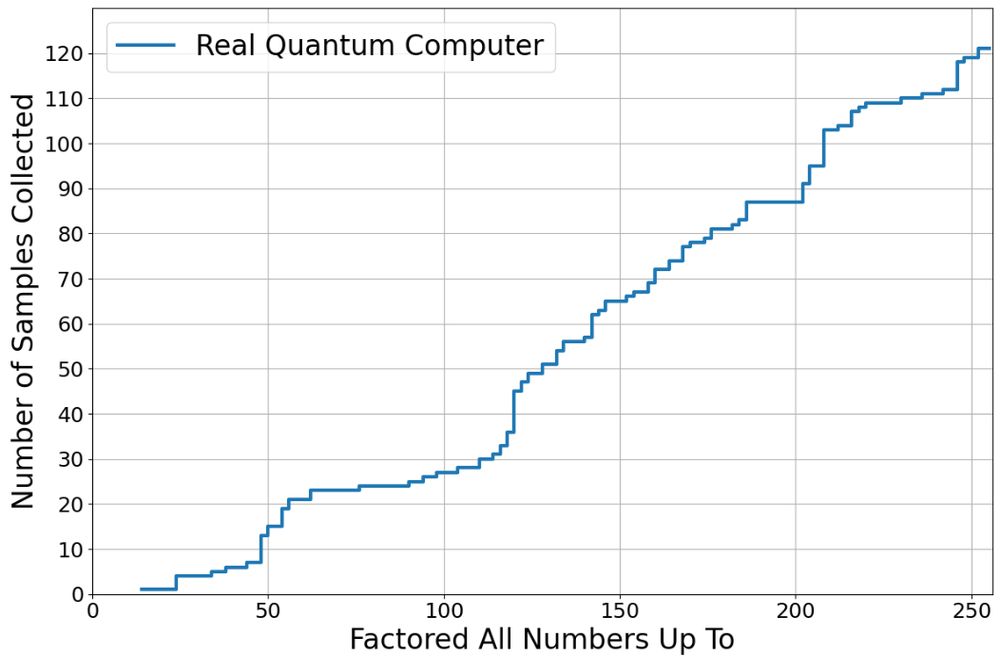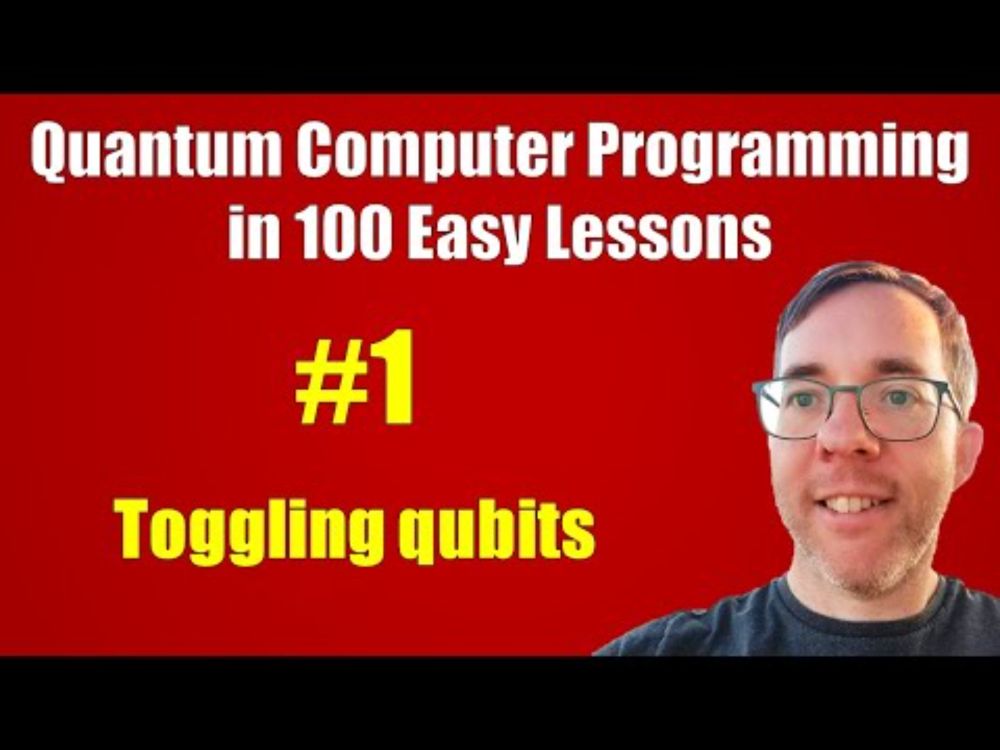Ryan O'Donnell
@booleananalysis.bsky.social
Kewen Wu on "No exponential quantum speedup for SIS∞ anymore"...
Or if you prefer a special case, "Subset-Sum with vectors mod 3":
www.youtube.com/watch?v=Pl2b...
Or if you prefer a special case, "Subset-Sum with vectors mod 3":
www.youtube.com/watch?v=Pl2b...

No Exponential Quantum Speedup for SIS^inf Anymore - Kewen Wu
YouTube video by Institute for Advanced Study
www.youtube.com
November 5, 2025 at 2:42 AM
Kewen Wu on "No exponential quantum speedup for SIS∞ anymore"...
Or if you prefer a special case, "Subset-Sum with vectors mod 3":
www.youtube.com/watch?v=Pl2b...
Or if you prefer a special case, "Subset-Sum with vectors mod 3":
www.youtube.com/watch?v=Pl2b...
Reposted by Ryan O'Donnell
Congratulations to Venkat Guruswami, new director of the Simons Institute for the Theory of Computing (@simonsinstitute.bsky.social)! And congrats to us, the Theoretical CS community, for having someone as good, dedicated, and wonderful as him at the helm of a place so important to us! #TCSSky
October 30, 2025 at 8:18 PM
Congratulations to Venkat Guruswami, new director of the Simons Institute for the Theory of Computing (@simonsinstitute.bsky.social)! And congrats to us, the Theoretical CS community, for having someone as good, dedicated, and wonderful as him at the helm of a place so important to us! #TCSSky

October 11, 2025 at 1:07 PM
Reposted by Ryan O'Donnell
Feeling depressed and anxious about the state of the world? Try working on a 375 year-old math problem from the Platonic realm, which should be completely psychologically safe . . .
youtu.be/QH4MviUE0_s
youtu.be/QH4MviUE0_s

Rupert's Snub Cube and other Math Holes
YouTube video by suckerpinch
youtu.be
September 16, 2025 at 2:23 PM
Feeling depressed and anxious about the state of the world? Try working on a 375 year-old math problem from the Platonic realm, which should be completely psychologically safe . . .
youtu.be/QH4MviUE0_s
youtu.be/QH4MviUE0_s
Please take a minute and nominate your favourite paper from FOCS 1995, 2005, or 2015 for the FOCS Test Of Time Award!
1995 papers: dblp.org/db/conf/focs...
2005 papers: dblp.org/db/conf/focs...
2015 papers: dblp.org/db/conf/focs...
Nomination instructions here:
tc.computer.org/tcmf/2025/08...
1995 papers: dblp.org/db/conf/focs...
2005 papers: dblp.org/db/conf/focs...
2015 papers: dblp.org/db/conf/focs...
Nomination instructions here:
tc.computer.org/tcmf/2025/08...
FOCS Test of Time Award - Call for Nominations 2025 - IEEE Computer Society Technical Committee on Mathematical Foundations of Computing
FOCS 2025 Test of Time Awards Call for Nominations The 2025 FOCS Test of Time Awards, awarded annually, recognize papers published in the Proceedings of the Annual IEEE Symposium on Foundations of...
tc.computer.org
August 26, 2025 at 3:47 PM
Please take a minute and nominate your favourite paper from FOCS 1995, 2005, or 2015 for the FOCS Test Of Time Award!
1995 papers: dblp.org/db/conf/focs...
2005 papers: dblp.org/db/conf/focs...
2015 papers: dblp.org/db/conf/focs...
Nomination instructions here:
tc.computer.org/tcmf/2025/08...
1995 papers: dblp.org/db/conf/focs...
2005 papers: dblp.org/db/conf/focs...
2015 papers: dblp.org/db/conf/focs...
Nomination instructions here:
tc.computer.org/tcmf/2025/08...
Reposted by Ryan O'Donnell
NSF announces funding for ICARM: the Institute for Computer-Aided Reasoning in Mathematics, based in Carnegie-Mellon . Amazing! Carnegie-Mellon press release here: www.cmu.edu/news/stories...
www.nsf.gov/news/nsf-inv...
www.nsf.gov/news/nsf-inv...

NSF invests over $74 million in 6 mathematical sciences research institutes
The U.S. National Science Foundation is investing over $74 million in six research institutes focused on the mathematical sciences and their broad applications in all fields of science, technology and...
www.nsf.gov
August 4, 2025 at 3:22 PM
NSF announces funding for ICARM: the Institute for Computer-Aided Reasoning in Mathematics, based in Carnegie-Mellon . Amazing! Carnegie-Mellon press release here: www.cmu.edu/news/stories...
www.nsf.gov/news/nsf-inv...
www.nsf.gov/news/nsf-inv...
Reposted by Ryan O'Donnell
After 3 1/2 years of work my course on quantum computing is finally finished — the "Director's Cut" of Understanding Quantum Information and Computation is now available.
arxiv.org/abs/2507.11536
arxiv.org/abs/2507.11536

Understanding Quantum Information and Computation
This is a course on the theory of quantum computing. It consists of 16 lessons, each with a video and written component, covering the basics of quantum information, quantum algorithms (including query...
arxiv.org
July 16, 2025 at 11:06 AM
After 3 1/2 years of work my course on quantum computing is finally finished — the "Director's Cut" of Understanding Quantum Information and Computation is now available.
arxiv.org/abs/2507.11536
arxiv.org/abs/2507.11536
Reposted by Ryan O'Donnell
New work with @booleananalysis.bsky.social! We prove instance-optimal bounds for quantum state certification when testers can measure all copies simultaneously, finding that the optimal copy complexity depends on how close to maximally mixed the hypothesis state is.
arxiv.org/abs/2507.06010
1/3
arxiv.org/abs/2507.06010
1/3

July 9, 2025 at 2:15 PM
New work with @booleananalysis.bsky.social! We prove instance-optimal bounds for quantum state certification when testers can measure all copies simultaneously, finding that the optimal copy complexity depends on how close to maximally mixed the hypothesis state is.
arxiv.org/abs/2507.06010
1/3
arxiv.org/abs/2507.06010
1/3
Spread the word: there is a new prize in Theoretical Computer Science in honor of Luca Trevisan--
cs.unibocconi.eu/call-nominat...
(Intent-to-nominate letters due by July 31.)
cs.unibocconi.eu/call-nominat...
(Intent-to-nominate letters due by July 31.)
cs.unibocconi.eu
June 9, 2025 at 12:46 PM
Spread the word: there is a new prize in Theoretical Computer Science in honor of Luca Trevisan--
cs.unibocconi.eu/call-nominat...
(Intent-to-nominate letters due by July 31.)
cs.unibocconi.eu/call-nominat...
(Intent-to-nominate letters due by July 31.)
Sigbovik's looking good this year. Come for the tom7/suckerpinch video preview, stay for Shor vs a random number generator...
For sigbovik, I factored all 8 bit ints (up to 255) with a quantum computer github.com/strilanc/fal...
I did it as legit as I possibly could. I ran a correct circuit with no optimization shenanigans. I did correct pre/postprocessing.
It took 121 quantum samples to finish the entire task.
But...
I did it as legit as I possibly could. I ran a correct circuit with no optimization shenanigans. I did correct pre/postprocessing.
It took 121 quantum samples to finish the entire task.
But...

April 2, 2025 at 11:24 AM
Sigbovik's looking good this year. Come for the tom7/suckerpinch video preview, stay for Shor vs a random number generator...
Reposted by Ryan O'Donnell
#STOC2025 (June 23-27, Prague) Theory Fest is looking for workshop proposals. The deadline is March 9th.
Apply here: stoc2025theoryfest.netlify.app
Apply here: stoc2025theoryfest.netlify.app
Vite + React + TS
stoc2025theoryfest.netlify.app
February 27, 2025 at 12:51 PM
#STOC2025 (June 23-27, Prague) Theory Fest is looking for workshop proposals. The deadline is March 9th.
Apply here: stoc2025theoryfest.netlify.app
Apply here: stoc2025theoryfest.netlify.app
Reposted by Ryan O'Donnell
New paper: Simulating Time With Square-Root Space
people.csail.mit.edu/rrw/time-vs-...
It's still hard for me to believe it myself, but I seem to have shown that TIME[t] is contained in SPACE[sqrt{t log t}].
To appear in STOC. Comments are very welcome!
people.csail.mit.edu/rrw/time-vs-...
It's still hard for me to believe it myself, but I seem to have shown that TIME[t] is contained in SPACE[sqrt{t log t}].
To appear in STOC. Comments are very welcome!
people.csail.mit.edu
February 21, 2025 at 10:19 PM
New paper: Simulating Time With Square-Root Space
people.csail.mit.edu/rrw/time-vs-...
It's still hard for me to believe it myself, but I seem to have shown that TIME[t] is contained in SPACE[sqrt{t log t}].
To appear in STOC. Comments are very welcome!
people.csail.mit.edu/rrw/time-vs-...
It's still hard for me to believe it myself, but I seem to have shown that TIME[t] is contained in SPACE[sqrt{t log t}].
To appear in STOC. Comments are very welcome!
PL puzzle. Say we have instructions called
"x1 += x2", "x2 += x3", "x3 += x4",
and versions with "-=" that cancel them.
We define a program
"x1 += x2"
"x2 += x3"
"x1 -= x2"
"x2 -= x3",
and abbreviate it "x1 -= x3". We similarly define "x2 -= x4".
We posit that "x1 -= x3" commutes with [...]
"x1 += x2", "x2 += x3", "x3 += x4",
and versions with "-=" that cancel them.
We define a program
"x1 += x2"
"x2 += x3"
"x1 -= x2"
"x2 -= x3",
and abbreviate it "x1 -= x3". We similarly define "x2 -= x4".
We posit that "x1 -= x3" commutes with [...]
February 10, 2025 at 9:42 PM
PL puzzle. Say we have instructions called
"x1 += x2", "x2 += x3", "x3 += x4",
and versions with "-=" that cancel them.
We define a program
"x1 += x2"
"x2 += x3"
"x1 -= x2"
"x2 -= x3",
and abbreviate it "x1 -= x3". We similarly define "x2 -= x4".
We posit that "x1 -= x3" commutes with [...]
"x1 += x2", "x2 += x3", "x3 += x4",
and versions with "-=" that cancel them.
We define a program
"x1 += x2"
"x2 += x3"
"x1 -= x2"
"x2 -= x3",
and abbreviate it "x1 -= x3". We similarly define "x2 -= x4".
We posit that "x1 -= x3" commutes with [...]
Group theory puzzle. We have symbols ♀️,🏁,♂️.
Also define ♕=♀️🏁♀️⁻¹🏁⁻¹ and ♔=♂️🏁♂️⁻¹🏁⁻¹.
We posit:
♀️♕=♕♀️ and 🏁♕=♕🏁 and ♂️♔=♔♂️ and 🏁♔=♔🏁.
And we posit:
♀️²⁰²⁵=🏁²⁰²⁵=♂️²⁰²⁵=1 (identity).
Can you prove ♕♔=♔♕?
Also define ♕=♀️🏁♀️⁻¹🏁⁻¹ and ♔=♂️🏁♂️⁻¹🏁⁻¹.
We posit:
♀️♕=♕♀️ and 🏁♕=♕🏁 and ♂️♔=♔♂️ and 🏁♔=♔🏁.
And we posit:
♀️²⁰²⁵=🏁²⁰²⁵=♂️²⁰²⁵=1 (identity).
Can you prove ♕♔=♔♕?
February 8, 2025 at 8:55 PM
Group theory puzzle. We have symbols ♀️,🏁,♂️.
Also define ♕=♀️🏁♀️⁻¹🏁⁻¹ and ♔=♂️🏁♂️⁻¹🏁⁻¹.
We posit:
♀️♕=♕♀️ and 🏁♕=♕🏁 and ♂️♔=♔♂️ and 🏁♔=♔🏁.
And we posit:
♀️²⁰²⁵=🏁²⁰²⁵=♂️²⁰²⁵=1 (identity).
Can you prove ♕♔=♔♕?
Also define ♕=♀️🏁♀️⁻¹🏁⁻¹ and ♔=♂️🏁♂️⁻¹🏁⁻¹.
We posit:
♀️♕=♕♀️ and 🏁♕=♕🏁 and ♂️♔=♔♂️ and 🏁♔=♔🏁.
And we posit:
♀️²⁰²⁵=🏁²⁰²⁵=♂️²⁰²⁵=1 (identity).
Can you prove ♕♔=♔♕?
Cayden Codel & Noah Singer have formalized in Lean the climactic theorems of the Kaufman-Oppenheim paper that shows the A_3-type coset complex HDXs are cosystolic expanders! (I.e., Sec. 7.2 of arxiv.org/abs/1907.01259)
It's a warmup for the main project...
It's a warmup for the main project...
arxiv.org
January 9, 2025 at 10:51 PM
Cayden Codel & Noah Singer have formalized in Lean the climactic theorems of the Kaufman-Oppenheim paper that shows the A_3-type coset complex HDXs are cosystolic expanders! (I.e., Sec. 7.2 of arxiv.org/abs/1907.01259)
It's a warmup for the main project...
It's a warmup for the main project...
Bravo to 1st-year undergraduate Tyler Yang at CMU, who was the first person to write up and make videos for all* 100 exercises in my "Quantum Computer Programming in 100 Easy Lessons" series! (www.youtube.com/watch?v=XtDJ...)
*more or less all
*more or less all

#1/100: Toggling qubits || Quantum Computer Programming in 100 Easy Lessons
YouTube video by Ryan O'Donnell
www.youtube.com
January 8, 2025 at 3:03 AM
Bravo to 1st-year undergraduate Tyler Yang at CMU, who was the first person to write up and make videos for all* 100 exercises in my "Quantum Computer Programming in 100 Easy Lessons" series! (www.youtube.com/watch?v=XtDJ...)
*more or less all
*more or less all
Random d-regular graphs are (2-sided) Ramanujan with probability 69%:
arxiv.org/pdf/2412.20263 by Jiaoyang Huang, Theo Mckenzie, HT Yau.
In particular, infinitely many 7-regular Ramanujan graphs exist.
arxiv.org/pdf/2412.20263 by Jiaoyang Huang, Theo Mckenzie, HT Yau.
In particular, infinitely many 7-regular Ramanujan graphs exist.
December 31, 2024 at 6:55 AM
Random d-regular graphs are (2-sided) Ramanujan with probability 69%:
arxiv.org/pdf/2412.20263 by Jiaoyang Huang, Theo Mckenzie, HT Yau.
In particular, infinitely many 7-regular Ramanujan graphs exist.
arxiv.org/pdf/2412.20263 by Jiaoyang Huang, Theo Mckenzie, HT Yau.
In particular, infinitely many 7-regular Ramanujan graphs exist.
In case you're in Cambridge, MA on Tue. Dec. 10, I'll give a talk at 4pm (MIT 32-G449) about coboundary expansion in high-dimensional expanders.
It's kind of about group theory, though.
toc.csail.mit.edu/node/1671
Besides coauthor Noah Singer (@singerng_), here's the cast of characters:
It's kind of about group theory, though.
toc.csail.mit.edu/node/1671
Besides coauthor Noah Singer (@singerng_), here's the cast of characters:

December 9, 2024 at 12:37 PM
In case you're in Cambridge, MA on Tue. Dec. 10, I'll give a talk at 4pm (MIT 32-G449) about coboundary expansion in high-dimensional expanders.
It's kind of about group theory, though.
toc.csail.mit.edu/node/1671
Besides coauthor Noah Singer (@singerng_), here's the cast of characters:
It's kind of about group theory, though.
toc.csail.mit.edu/node/1671
Besides coauthor Noah Singer (@singerng_), here's the cast of characters:
Reposted by Ryan O'Donnell
Bhangale, Khot, Liu, and Minzer improved the bounds for combinatorial lines of length 3, established in the Polymath project on the Hales-Jewett problem. Interestingly, this is done from a TCS perspective using pseudorandomness and inverse theorems for CSPs.
eccc.weizmann.ac.il/report/2024/...
eccc.weizmann.ac.il/report/2024/...
ECCC - TR24-193
eccc.weizmann.ac.il
November 23, 2024 at 2:18 PM
Bhangale, Khot, Liu, and Minzer improved the bounds for combinatorial lines of length 3, established in the Polymath project on the Hales-Jewett problem. Interestingly, this is done from a TCS perspective using pseudorandomness and inverse theorems for CSPs.
eccc.weizmann.ac.il/report/2024/...
eccc.weizmann.ac.il/report/2024/...
Reposted by Ryan O'Donnell
Great new quantum algorithm for approximate polynomial interpolation on the arXiv today:
"given a uniformly random vector y of F_q^q, some integers k<q and u < q/2, find a polynomial P(x) of degree <k such that
|P(i)-y_i| < u for all i".
quantum computers can help here (1/4)
"given a uniformly random vector y of F_q^q, some integers k<q and u < q/2, find a polynomial P(x) of degree <k such that
|P(i)-y_i| < u for all i".
quantum computers can help here (1/4)
November 20, 2024 at 7:54 AM
Great new quantum algorithm for approximate polynomial interpolation on the arXiv today:
"given a uniformly random vector y of F_q^q, some integers k<q and u < q/2, find a polynomial P(x) of degree <k such that
|P(i)-y_i| < u for all i".
quantum computers can help here (1/4)
"given a uniformly random vector y of F_q^q, some integers k<q and u < q/2, find a polynomial P(x) of degree <k such that
|P(i)-y_i| < u for all i".
quantum computers can help here (1/4)

